In the shadow of the Welsh Mountains, a small herd of Guernsey cows grazes the rolling pasture. Operated by Dina and Kevin Stoltzfus, Warwick Manor Farm is the source of the milk, ice cream and butter that are sold under the Golden Guernsey label at Yoder’s Country Market in New Holland.

Golden Guernsey’s strawberry, peach and blueberry cheesecake ice cream equates to summer in a bowl. As for the strawberry, it features generously large pieces of strawberries and bold flavor. The peach is luscious, with a robust, bright peach flavor and creamy mouthfeel. Blueberry is super sweet (as the name implies) and has an almost savory undertone. Lots of textures at play.
Dina’s parents, John and Darlene Yoder, started the market in 1980. The enterprise along Route 23 has grown to include a grocery, bake shop, restaurant, banquet space and pharmacy. The Yoders’ daughters, Dina and Denise, as well as their families, have all been involved in the business in different capacities.
When Dina and Kevin started farming together, they named Warwick Manor Farm in honor of the dairy farm his grandparents operated in Chester County, through which they offered a home delivery service from 1947 until the early 1980s. (Those days may seem a distant memory, but grocery delivery services offered by DoorDash and Whole Foods have modernized the concept.) Today, the Stoltzfus family is involved in farming the land and milking the 50-cow herd.
“We go to extreme lengths to keep things clean and comfortable for the cows,” says Kevin. Milked twice daily – typically at 4 a.m. and again at 4 p.m. – each milking takes about an hour. During those times, the compost bedding is tilled over in the empty dairy barn. After the morning milking, the herd spends the day in the barn or pasture, resting and grazing on grass. Cows have four compartments in their stomachs and “chew the cud” to digest food properly, often while lying down. Rest is a key component to the health of a dairy cow, and these Guernsey cows have ample room to stretch out.
The dairy barn on the farm is a repurposed warehouse. The structure offers higher ceilings and a larger footprint than is typical for a herd of 50 cows. What some farmers may consider excessive, Kevin considers essential. Fans and expansive windows allow for maximum ventilation to keep the cows cool in the summer. Herd health also ensures the highest quality buttermilk fat content and optimal milk production.
Making Ice Cream
From the farm, the milk travels a few miles down the road to Yoder’s Country Market. “The milk left the farm this morning and it’ll be in bottles at noon,” says Kevin of that morning’s yield. Viewable through a window at the market, Golden Guernsey milk is bottled and then sold a few feet away. “The next day, the cream is added to milk and ingredients to make ice cream mix,” he explains.
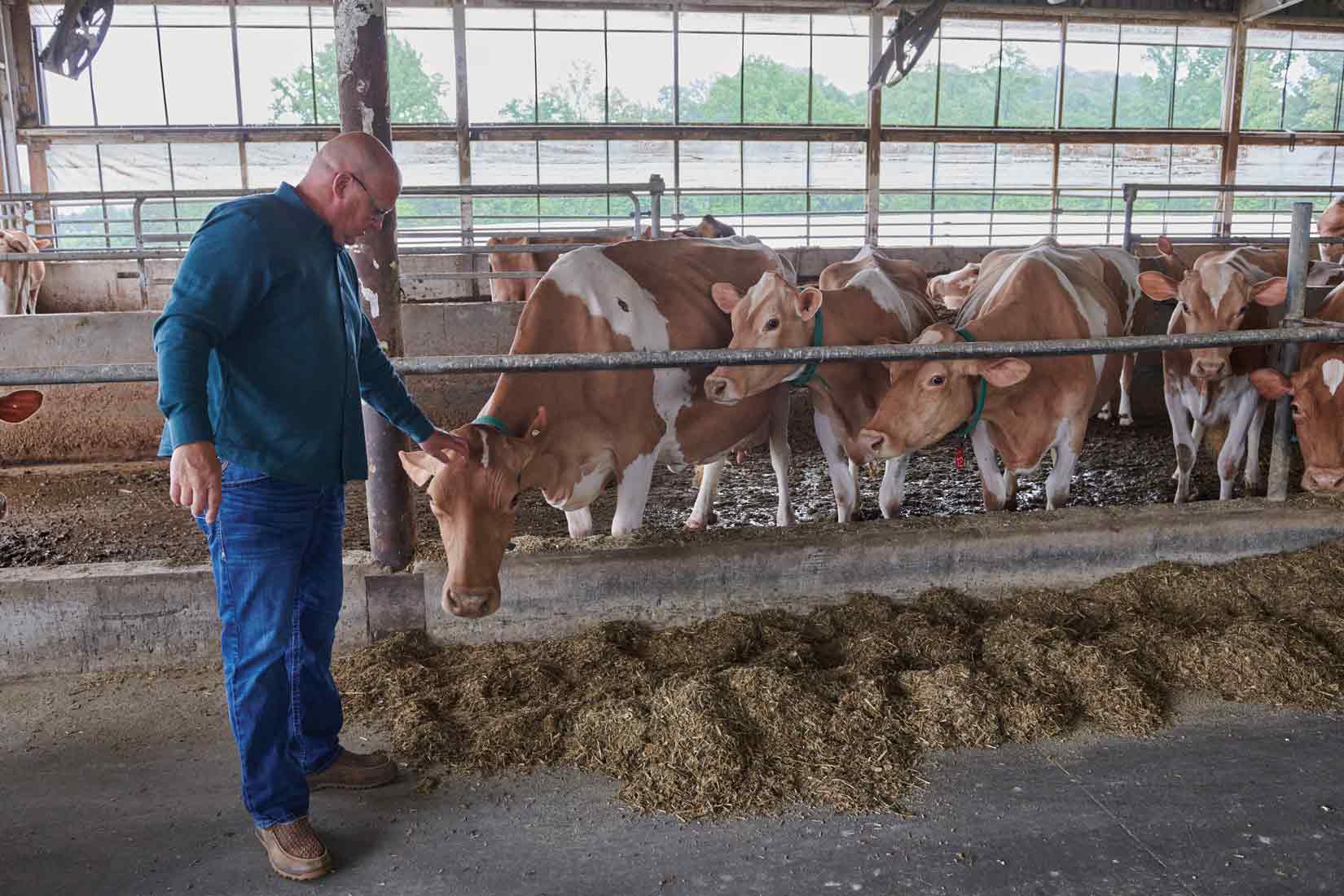
Kevin Stoltzfus stops to pet one of the Guernsey cows as he makes his way through the barn. According to Kevin, cows can be extremely curious around people, particularly if they’ve been around them from birth.
“Every ice cream starts with a base mix,” Kevin continues. “Milk, cream, sugar, stabilizer, from there it’s adding flavoring. If we make a 200-gallon base mix, we can split that and turn 100 of that into vanilla, and 100 into strawberry.” Offering 25 varieties, plus additional seasonal flavors, as well as several no-sugar-added options, Golden Guernsey’s regular ice cream flavors are available in pint, half-gallon, gallon and three-gallon containers.
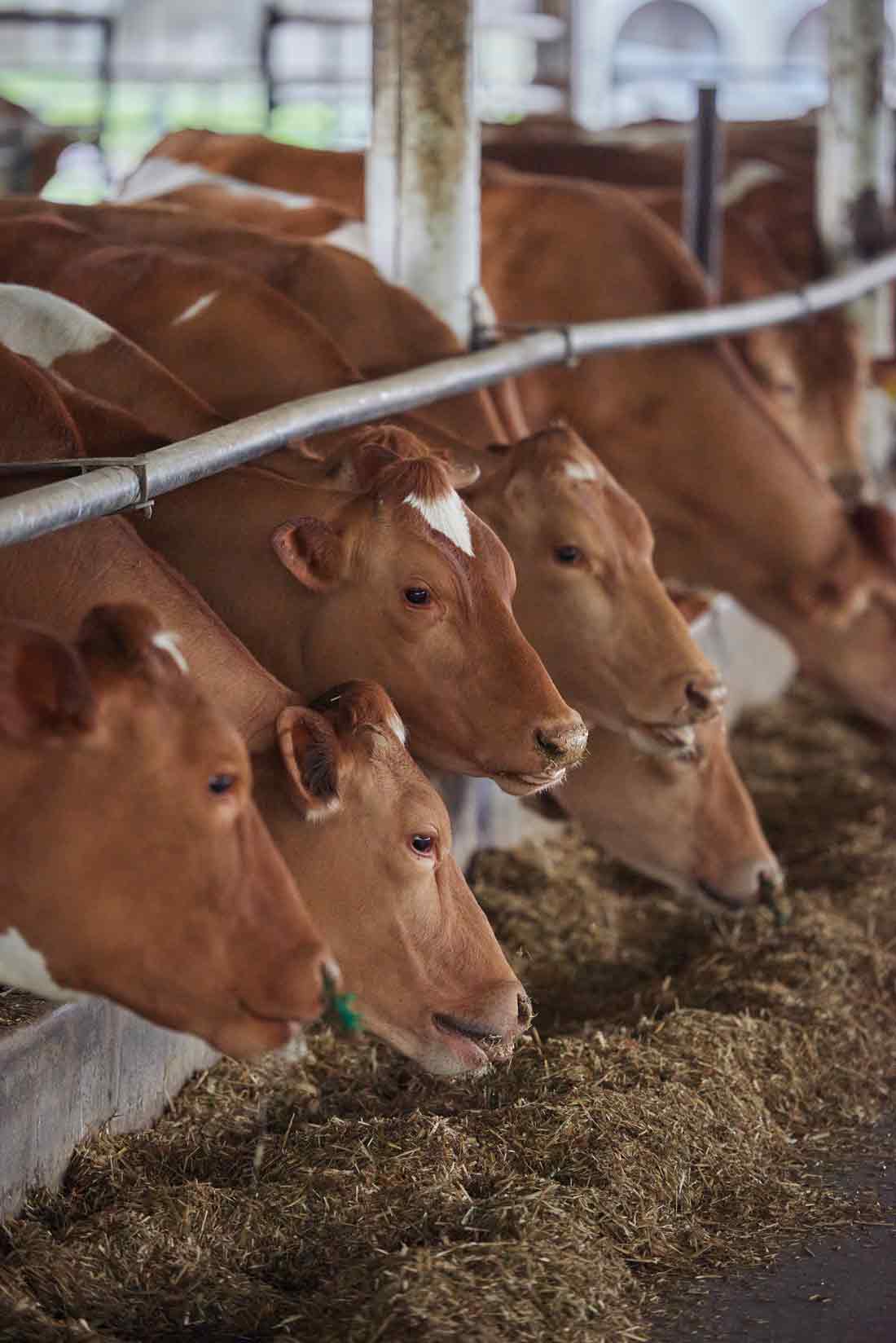
Grass feed grown on the farm makes up the majority of the Guernsey diet. The grass is rich in beta-carotene, a key nutrient in their milk.
A unique benefit of having an interconnected dairy, market and restaurant relates to instant consumer feedback. For example, customers at the restaurant can try new ice cream flavors, allowing Kevin to receive feedback from the restaurant staff who work the dipping cabinet that offers six flavors. “We can tell if a new flavor went over really well in our store sales, and I’ll just go over to the restaurant and ask how it did in the dipping cabinet,” he says. The most popular special varieties have a chance of becoming regular flavors.
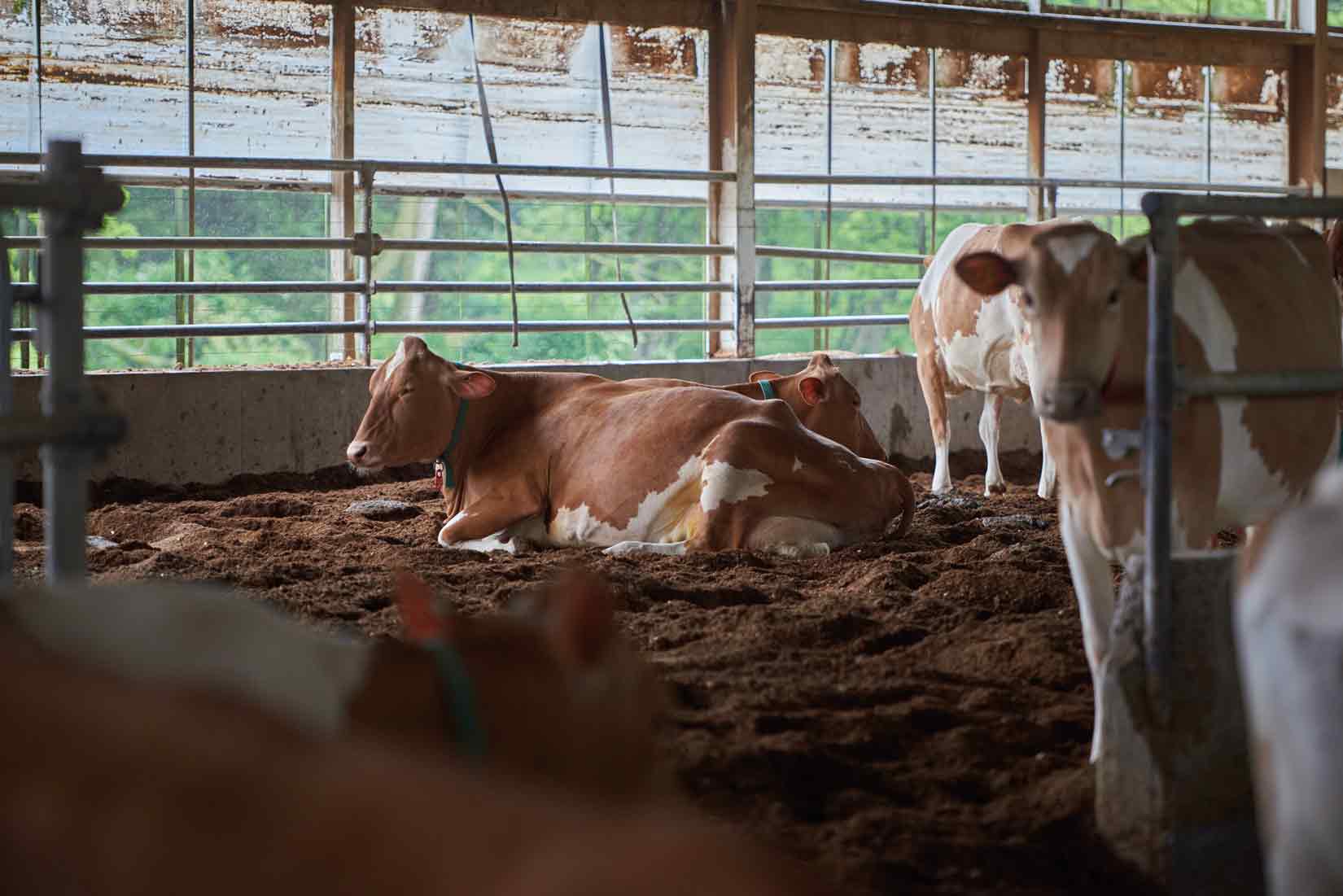
Resting is a key element of herd health and productivity. Here the cows have ample room to rest and chew their cuds.
Restaurant guests are often surprised to learn that the ice cream is made on the premises. “People often say, ‘Oh, this is your own ice cream?’” Dina says, adding that having it available in the store plays into the concept of instant gratification, as guests can take home the same ice cream they enjoyed with their meal.
Milk and Cream
We can’t talk about ice cream making without discussing how dairy milk and cream are allocated. Full-fat Guernsey milk starts at around 5 to 5.5% fat by weight. To make whole, reduced-fat and skim milk, fat is “skimmed” off milk to leave the right amount behind. “Skim milk has no cream,” says Kevin. “Whole milk, you’re leaving 3.25%. That process leaves you with cream. State law requires whole milk to be [at least] 3.25% fat. Skim milk cannot go over .5% fat [Yoder’s is .2%]. It’s pasteurized and run through a separator to separate the cream out for different fat levels you want in the milk,” he adds.
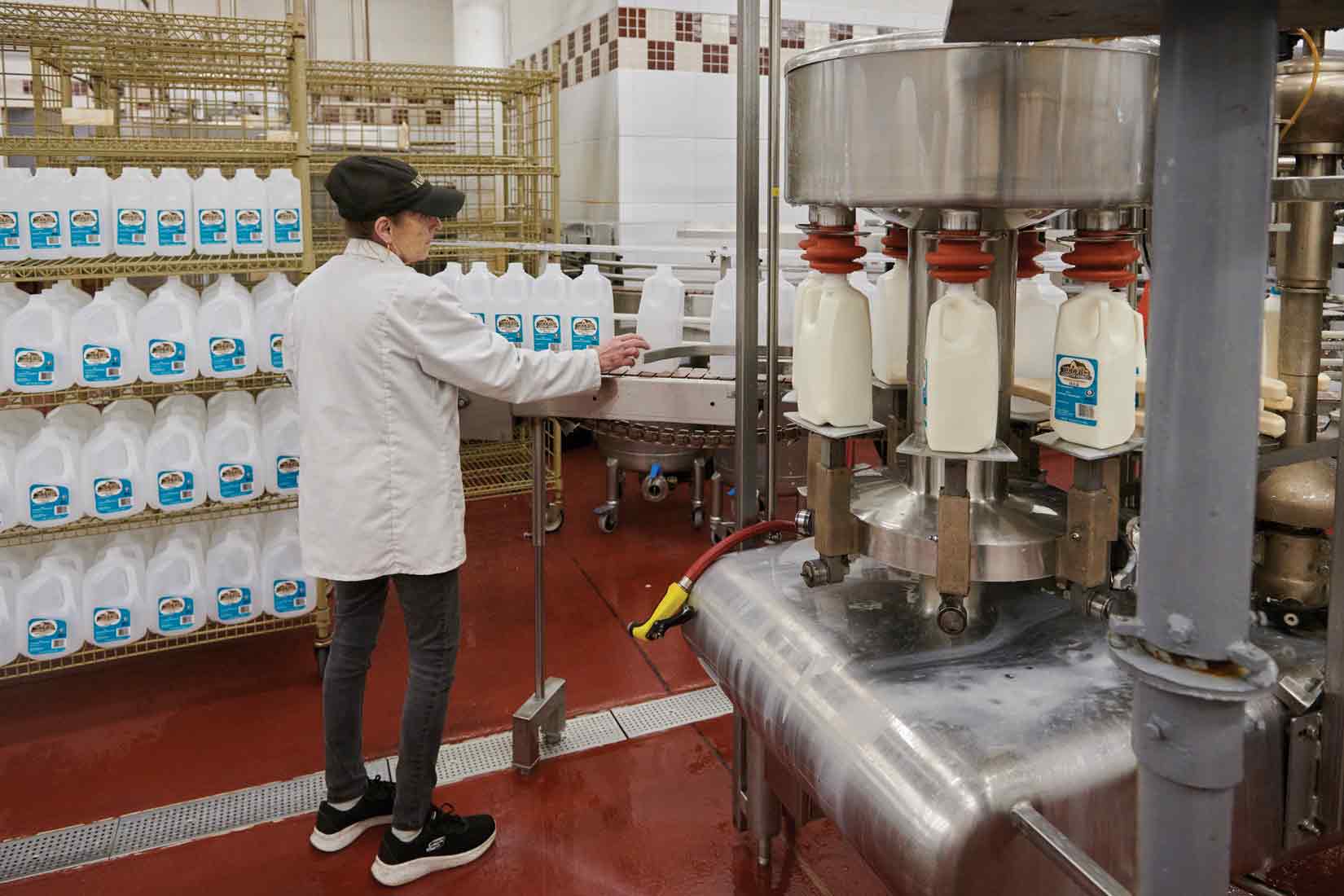
Cindy Miller bottles Golden Guernsey milk at Yoder’s Country Market. Whole milk must be a minimum of 3.25% milk fat by weight, and skim milk is set at .5% milk fat. Labels are applied to plastic milk jugs by hand. Milk is available in glass bottles.
Milk bottled between whole and skim varieties can be at any defined percentage set by the dairy and its capacity. “Whatever your label says, 1%, 2% – ours is 1.5% – that’s what it needs to be,” says Kevin.
The size and productivity of the herd define how many products are available from the dairy. As a smaller dairy, Golden Guernsey uses the reserved cream (from offering 1.5%, and not 2%) to increase ice cream and butter production. For comparison, butter is 80% butterfat, while heavy cream is usually above 36%. If you’ve seen signs along the road stating, “Drink Local Whole Milk 97% Fat-Free”, it’s simply a repositioning of milk’s 3% fat content.
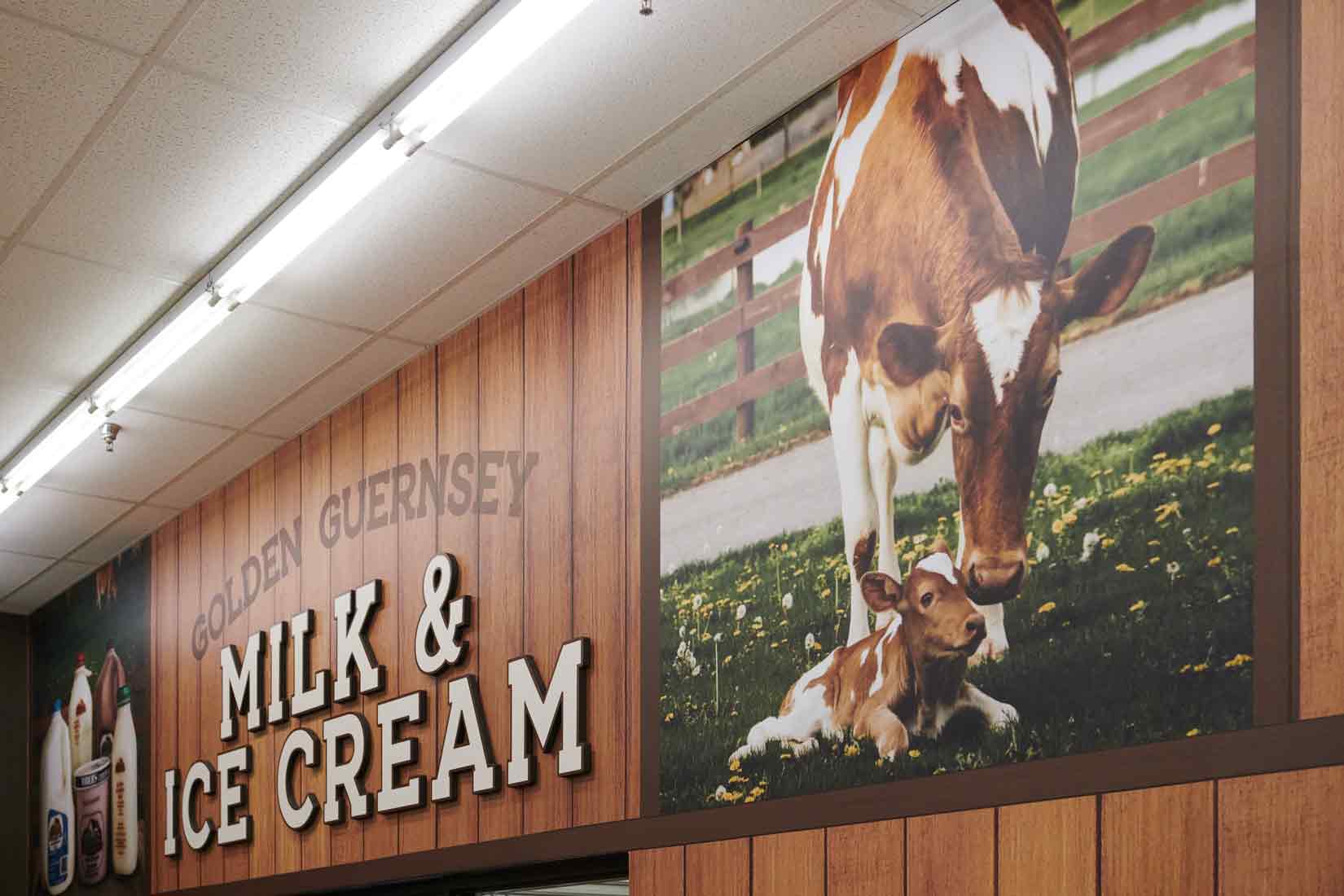
The creamery section at Yoder’s Country Market features chocolate milk that has a creamy but light texture.
If you’ve ever heard of or seen a “cream line” in milk, that’s where homogenization comes in. Like pulp in orange juice, homogenization is for the convenience and aesthetic of not needing to shake milk (like in the old days) when the cream rises to the top. The process doesn’t change the percentage of fat content in bottled milk, it only skims off larger fat particles. Pasteurization is simply the process of heating milk to 161 degrees F held for at least 15 seconds. This kills potential bacteria, such as E. coli, listeria and salmonella, while preventing possible diseases such as tuberculosis. Nothing is added in either process.
Foodies take note: selling milk with a fat content over 3.25% is left up to the dairy. Kevin has considered selling premium, full-fat, pasteurized milk, without any cream removed, leaving it at over 5% milk fat by weight. But doing so would affect the other products, as cream available for making ice cream or butter would be reduced, necessitating a premium price. However, this would be an excellent option for baking, cheesemaking, lattes … anywhere a richer milk is desirable.
The Golden Guernsey
Not all dairy breeds of cattle are equal, nor is their milk. Of the seven standard dairy cow varieties in the United States, black-and-white Holsteins are easily recognizable. Guernseys, which are light brown with white spots, originated from the Isle of Guernsey in the English Channel. Their not-so-distant neighbors, Jersey cattle, are from the Isle of Jersey. Both isles are located near the coastline of France but are part of the United Kingdom.
“Guernsey and Jersey [cows] milk are the most similar,” says Kevin. “They’re like first cousins. Of all the milk, they’re a higher fat content, a higher protein.” With a grass-fed diet high in beta carotene (think carrots), “Guernseys pass beta carotene into their milk, and that gives it the golden color,” he continues.
Guernsey milk is sometimes advertised as A2/A2 milk. In simple terms, it’s more easily digestible for most people, offering better nutrient absorption, thanks to the beta-casein protein it contains. That’s different from both a milk allergy (immune reaction) and lactose intolerance (inability to digest lactose, a milk sugar) perspective. If the milk in your coffee or eating ice cream gives you a mild upset stomach, Golden Guernsey might be a better option. Another tip: choose whole milk over skim. Any milk with a higher percentage of fat means there is a lower percentage of lactose by volume.
Reasons to Celebrate Ice Cream
July 17 is National Ice Cream Day. If another 30 days would help to satisfy your craving, July is National Ice Cream Month. After you recover from the July brain freeze, National Chocolate Milkshake Day is September 12, not to be confused with the informal Ice Cream for Breakfast Day, next February 1.
For more information, visit yoderscountrymarket.com/guernsey-milk.





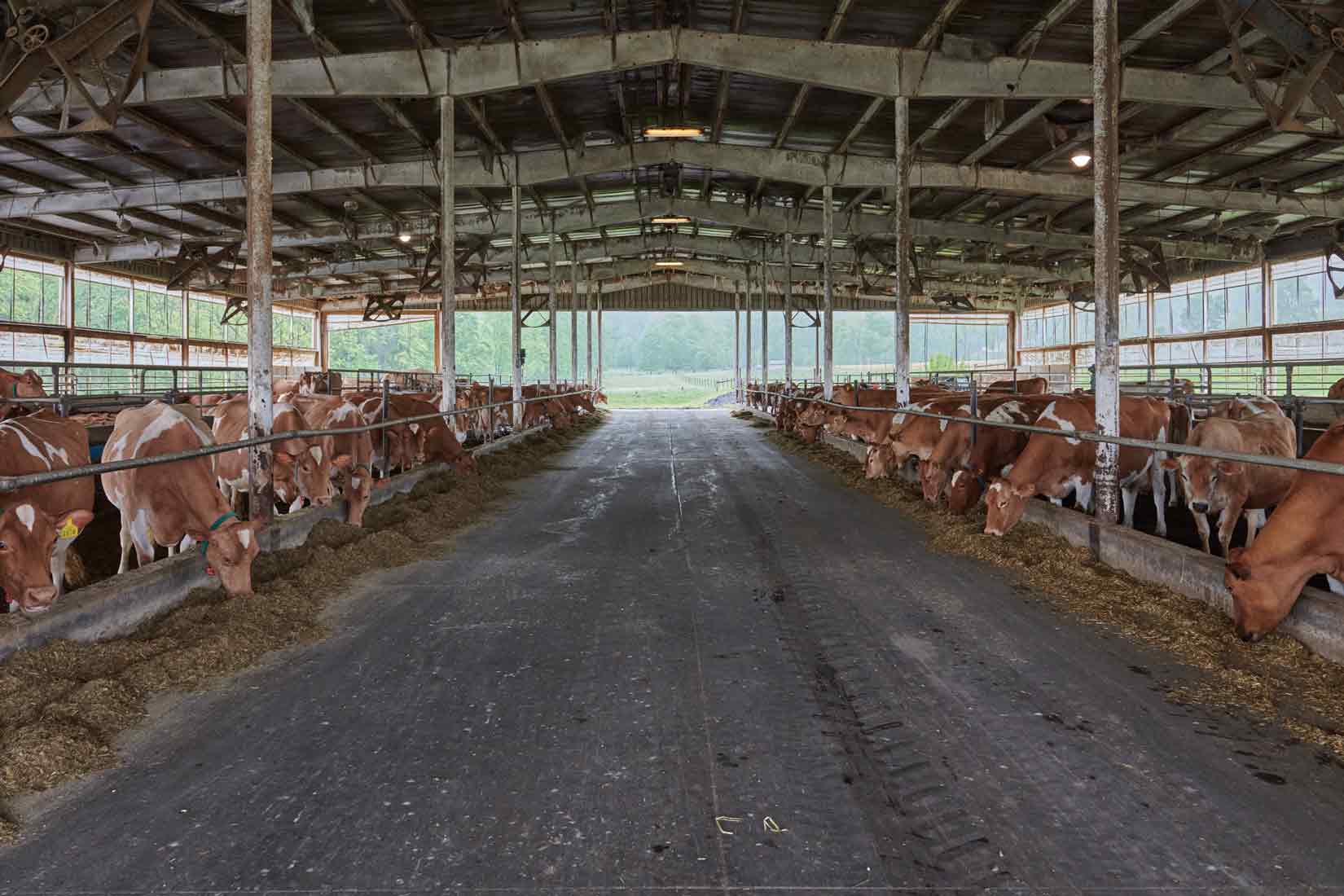
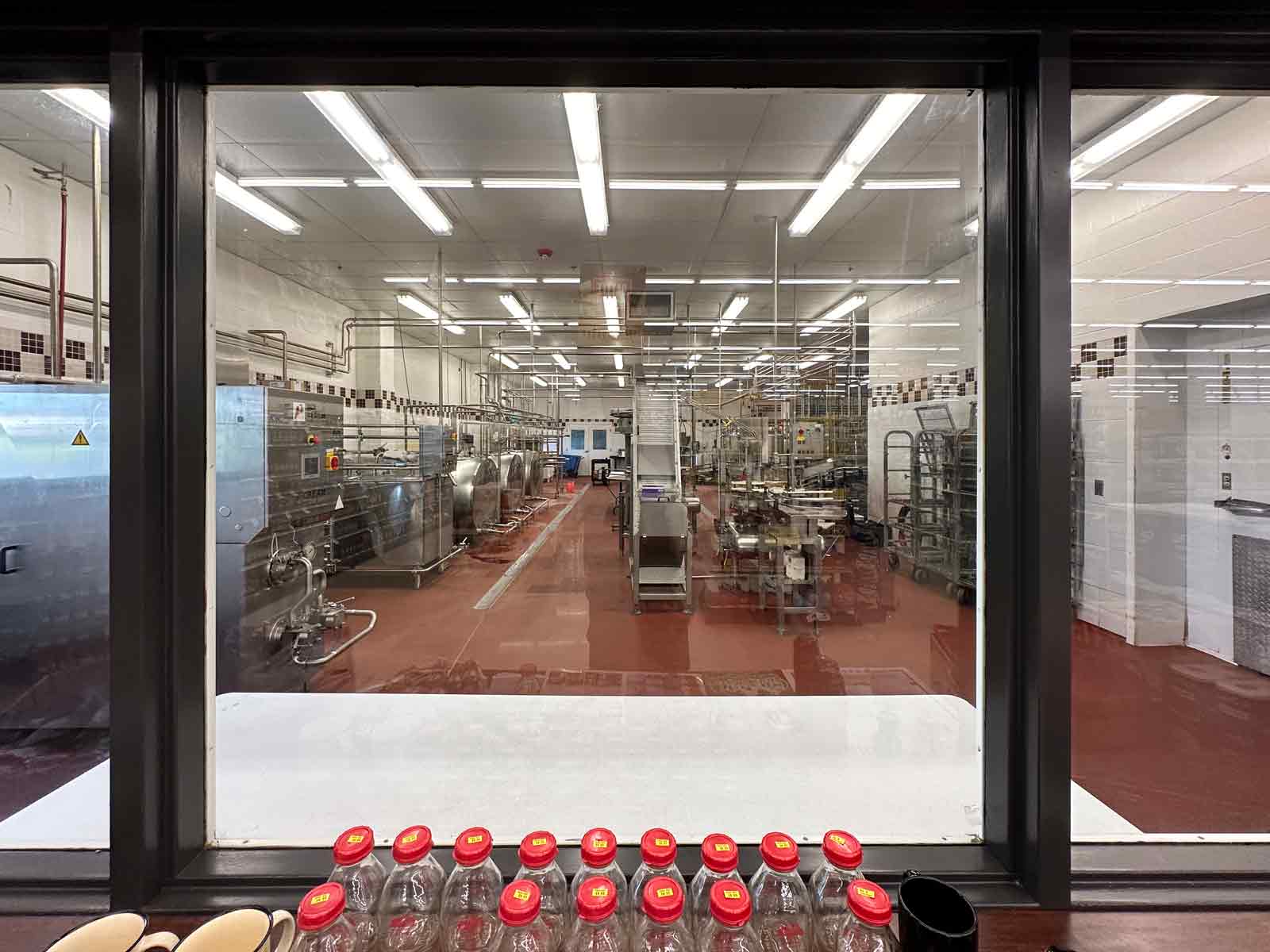
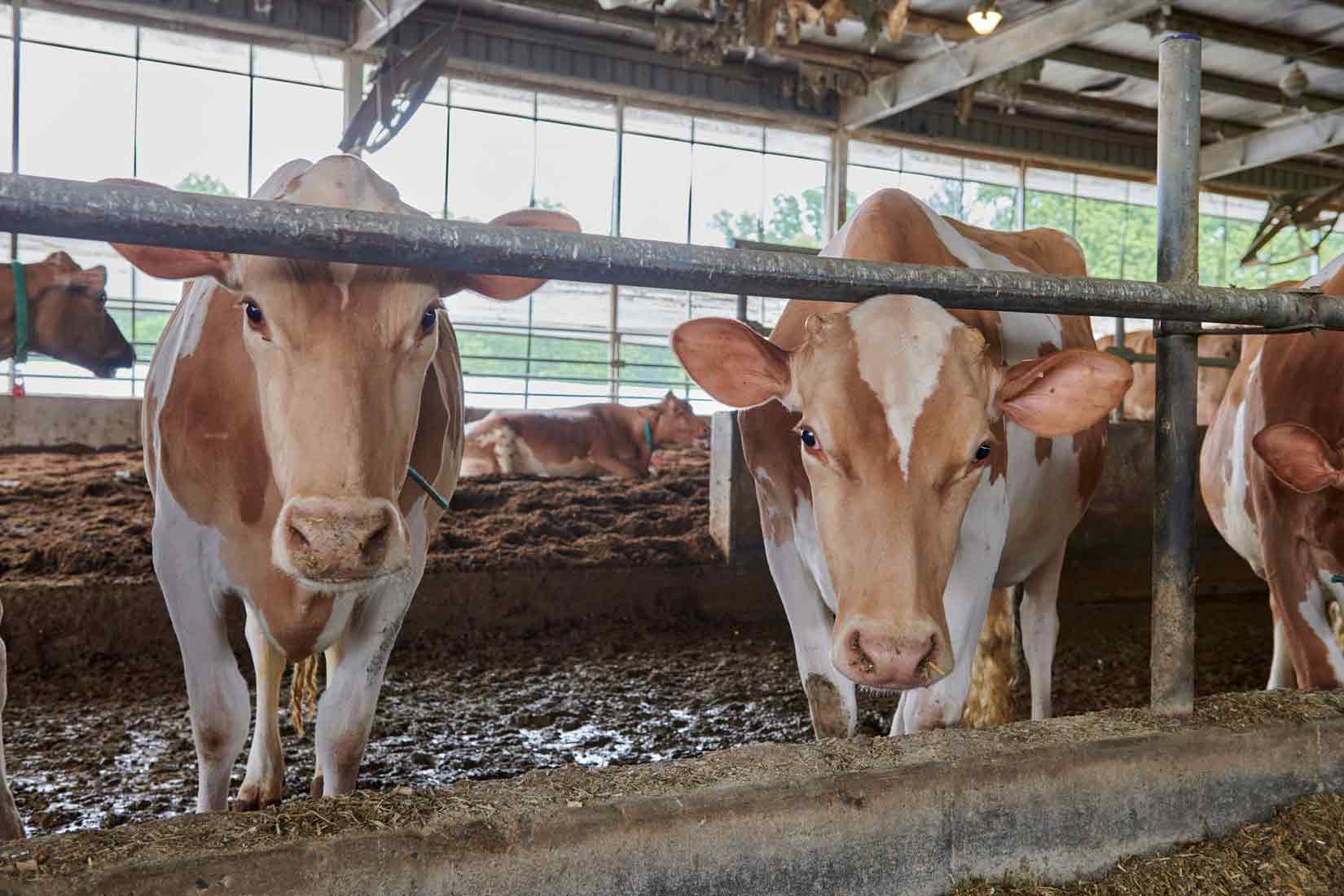
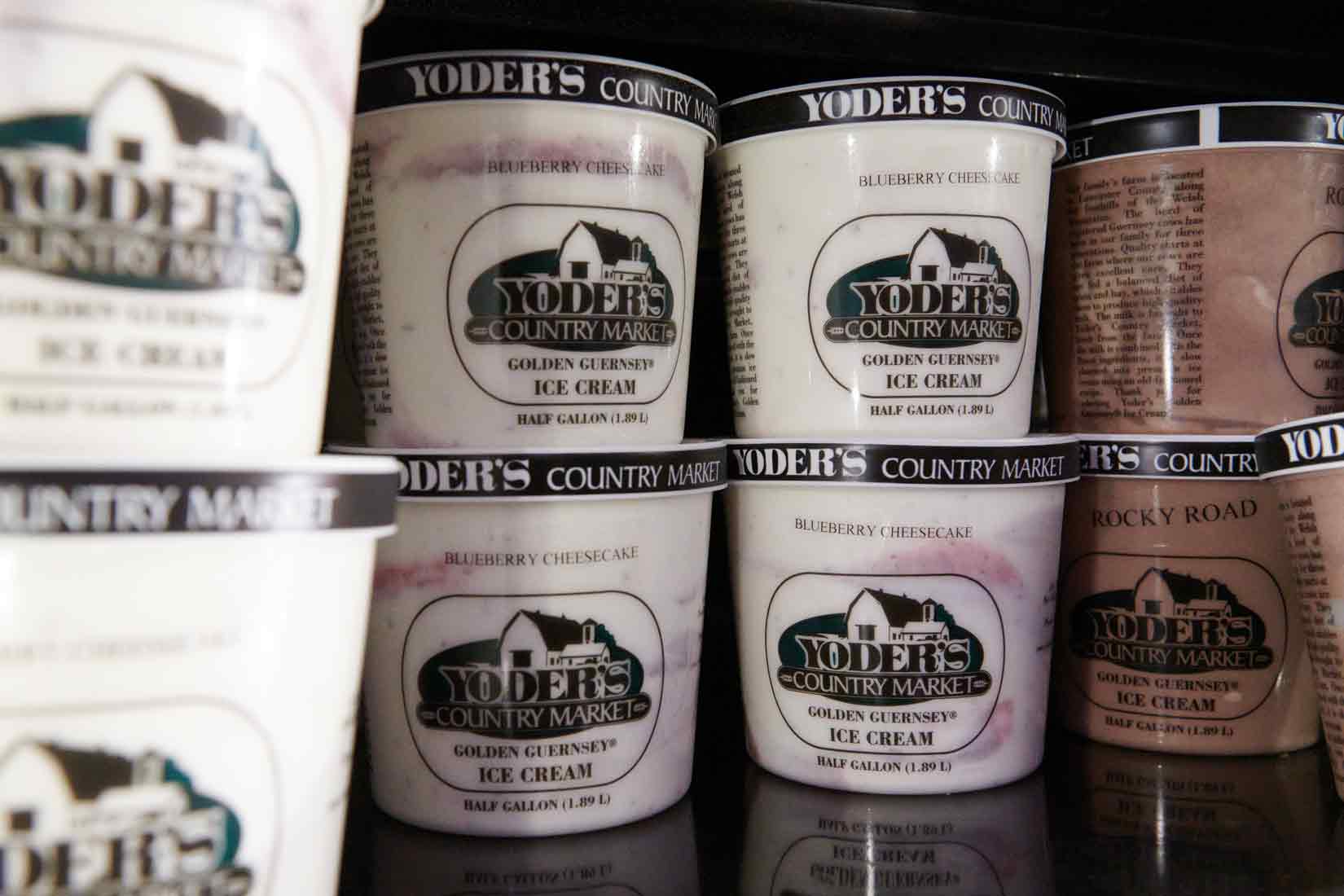
SHARE
PRINT